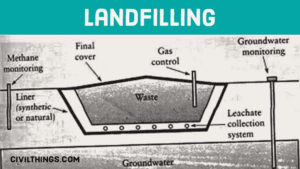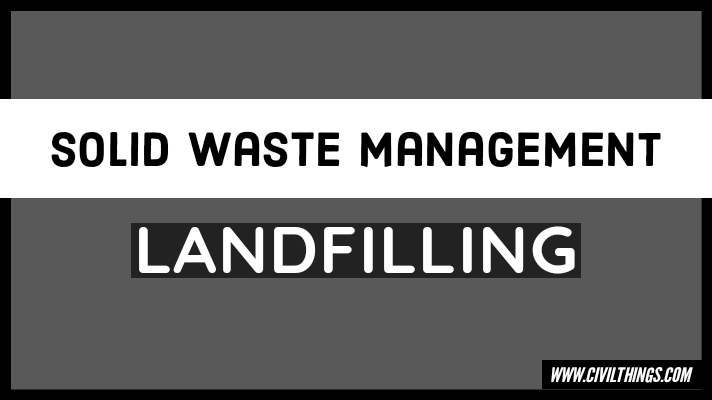disposal method of solid waste used in India and other countries is Sanitary landfilling, Incineration, Pyrolysis, and Composting.
Table of Contents
Various methods of Disposal of waste or used to treat
- Sanitary landfilling
- Incineration
- Pyrolysis
- Composting
Site selection criteria for landfilling.
When choosing a place for landfilling, we consider a few things:
- Available land area: We need to have enough space to put the waste without causing any problems.
- Haul distance: This means how far the waste has to be transported to the landfilling site. We want to minimize the distance to save time and resources.
- Soil conditions & topography: We look at the type of soil and the shape of the land because they can affect how well the waste can be stored.
- Surface water hydrology: This refers to how water moves on the surface of the land. We need to consider this to prevent any contamination of water sources.
- Climatic conditions: The weather in the area is important because it can affect how the waste breaks down over time.
- Local Environmental conditions: We also need to consider the local environment and make sure that landfilling won’t harm plants, animals, or other natural features.
- Ultimate use at the site: We think about what the land will be used for in the future after the waste is safely stored.
Methods of sanitary Landfilling
- Area Method
- Trench Method
- Depression Method
-
Area Method:
In this method, garbage is spread over a large area and then covered with soil. It helps to prevent bad smells and keeps the trash contained.
-
Trench Method:
In this method, a long trench is dug in the ground, and garbage is dumped into it. Once the trench is full, it is covered with soil. This method helps to organize the garbage and make sure it doesn’t spread around.
-
Depression Method:
In this method, a large hole or depression is dug in the ground, and garbage is dumped into it. Then, the garbage is covered with soil. This method helps to keep the garbage container out of sight.
Disadvantages of landfills,
-
Pollution:
Landfills that are not designed or operated properly can cause pollution. This means that the areas around the landfills become very dirty and unhealthy. The air, water, and soil can all become polluted.
2. Chemicals:
In poorly developed landfills, it is hard to stop dangerous chemicals from getting out and spreading to nearby areas. These chemicals can get into the ground and mix with the water that people use.
3. Diseases:
Landfills attract many insects and rodents, like flies and rats. These animals can carry diseases that can make people sick. So, people living near a landfill might be more likely to get sick.
- Landfilling can pollute air, water, and soil
- Area of surrounding the land field becomes heavily polluted
In summary, landfills that are not well-managed can cause pollution, spread dangerous chemicals, and increase the risk of diseases for the communities living nearby.

Landfills advantages
- Waste can be used as fuel: The waste in landfills can be burned directly to create heat and energy. Or, it can be turned into another type of fuel.
- Landfills can be monitored: We can keep an eye on landfills to make sure they are working properly and not causing harm to the environment.
- After a landfill is full, it can be turned into something useful: Once a landfill is filled up, we can clean it up and make it into a park or farmland.
- Recycling is possible: In well-designed landfills, we can separate recyclable materials and use them again before closing the landfill.
- Organic material can be separated: In a good landfill, we can separate organic waste, like food scraps, and use them to make compost or
- produce natural gas.
- Landfills can capture natural gas: When the waste underground in a landfill breaks down, it produces a gas called methane. Well-managed landfills can collect this gas and use it for energy.
FAQ:
Q: What is solid waste?
Q: Why is proper disposal of solid waste important?
Q: What are the different methods of solid waste disposal?
Q: What is landfilling?
Q: What is incineration?
Q: What is composting?
Q: What is recycling?
Q: What is waste-to-energy?
Q: How can I dispose of hazardous waste?
Q: What are some eco-friendly alternatives to solid waste disposal?
Q: How can I contribute to proper solid waste disposal?

Hi! I’m Sandip, a civil engineer who loves sharing about Civil Engineering & new ideas and tips. My blog helps you learn about engineering in a fun and easy way!

